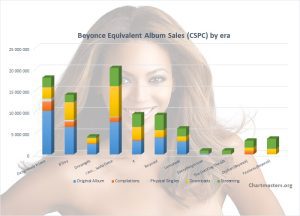Forum
Per Forbes, by the time Beyoncé released her last proper album Lemonade in 2016, she was worth $265 million. She is now up to $760 million.
It reveals how successful the superstar has been on several industries, to the surprise of nobody.
She now faces one of her strongest challenges yet. After smashing the physical era in her 20s with Destiny's Child and the download era in her 30s solo, now in her 40s, she is attempting to simultaneously sustain her relevance in the streaming age while pushing her artistic boundaries through releasing innovative projects.
This attempt has been successful so far, with both Renaissance (2022) and Cowboy Carter (2024) reaching #1 on the Billboard 200, and the latter even helped Beyoncé finally win the coveted Grammy Award for Album of the Year.
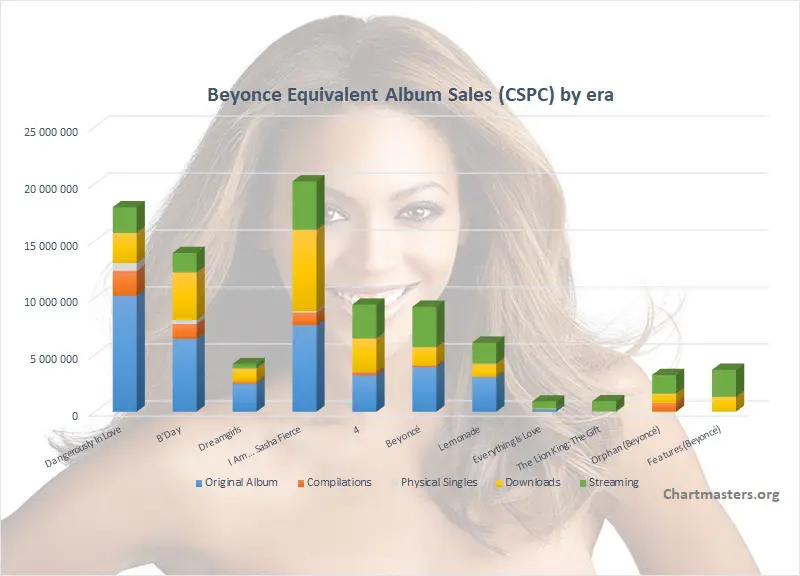
Undoubtedly, Beyoncé has been growing a lot since the days of No, No, No hit single way back in 1998.
The power women managed to become an icon for each community, females, blacks, and LGBT+.
She is also regarded as an accomplished women in her private life. She married rap legend Jay-Z, together, they are parents of 3 children.
As she sings on Formation, "I dream it, I work hard, I grind 'til I own it". It's difficult to contradict her, as it feels that she has the skills to turn everything into gold.
It all started in a very standard way with a string of successful eras with her group from 1998 to 2001.
It's during this period that she met and started to date Jay-Z. Retrospectively, this meeting can be regarded as a tremendous event for the music industry as a whole.
The relationship obviously brought several key hits to Beyoncé but the pair’s combined strengths also enabled them to invest in various brands from the Brooklyn Nets to TIDAL, developing more and more their status as business powerhouses.
The music industry is harsh though. As the main consumers are from 12 to 25, the have little memory, and identify better with singers in their own age range.
This didn't stop her latest releases from breaking streaming records upon release though, but how do they hold up against her previous albums? This article hopes to answer that and many more regarding the discography of Beyoncé.
As usual, I'll be using the Commensurate Sales to Popularity Concept in order to relevantly gauge her results. This concept will not only bring you sales information for all Beyoncé's albums, physical and download singles, as well as audio and video streaming. In fact, it will also determine their true popularity.
If you are not yet familiar with the CSPC method, below is a nice and short video of explanations. I fully recommend watching it before getting into the sales figures. Of course, if you are a regular visitor feel free to skip the video and get into the numbers directly.
The Commensurate Sales to Popularity Concept (CSPC)
There are two ways to understand this revolutionary concept. In the first place, there is this Scribe video posted below. If you are unaware of the CSPC method, you will get the full idea within just a pair of minutes.
[adthrive-in-post-video-player video-id="qixxDCRj" upload-date="2023-11-08T15:43:50.000Z" name="Commensurate Sales to Popularity Analysis (CPSC) - Explanations.mp4" description="null" player-type="default" override-embed="default"]
If you are a mathematical person, and want to know the full method as well as formulas, you can read the full introduction article.
Now let's get into the artist's sales figures in detail in order to apply this concept and define the act's true popularity!
Beyoncé Album Sales

Original Album Sales - Comments
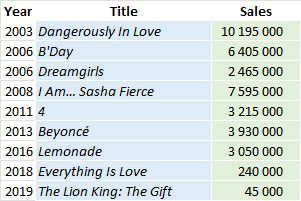
Now totaling 37.14 million copies sold, Beyonce‘s studio albums eventually topped sales of those from the Destiny’s Child in 2016.
As the solo star has now 9 albums, including 6 traditional ones, more than her past group, the fact that she topped them only now may sound surprising.
That only her debut LP reached the 10-million barrier is also quite intriguing considering how many 10-million sellers came out in the last 20 years, including sets from artists way less talked about these days like James Blunt or Dido.
The comparison with the Destiny’s Child isn’t completely fair through as 1999-2001 market was arguably much bigger than 2003+ years in terms of album sales.
Download sales took off during the Dangerously In Love era and slowed down only to be replaced by streaming. It means that music consumption got spread over more formats during the career of the diva.
How does the comparison stands after accounting for all those distinct formats?
Beyoncé songs sales
Below, we list down results from the artist through physical sales, digital sales and streaming.
Please be aware that when the artist is regarded as the lead act, he is rewarded with 100% of these units, while featured acts share among them a 50% piece of the totals.

Physical Singles
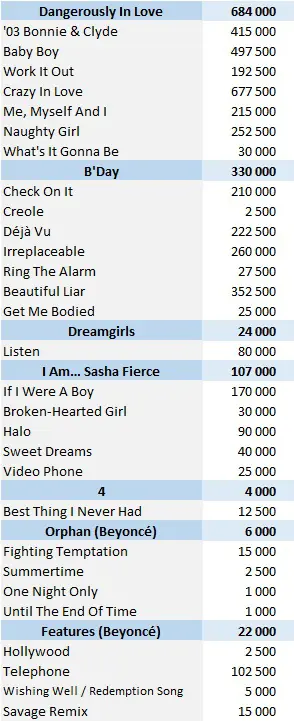
As a reminder, the weighting is done with a 10 to 3 ratio between one album and one physical single.
Naturally, the physical single market is not favorable for Beyoncé as downloads replaced them very early in her career.
Results reveal it very clearly, as her top 3 sellers are all from the Dangerously In Love era.
With 677,500 sales, Crazy In Love remains the biggest, with both Baby Boy and '03 Bonnie & Clyde over the 400,000 mark.
If we look at every song close to 200,000 sales and more, and there are 10, they are all from her first two albums.
She released few proper hit single in recent years too, so there are no collector items to take over sales from this avenue.
In fact, Best Thing I Never Had, which is now a decade old, is her latest CD single.
Her career total in this format adds for nearly 4 million copies, including 3.38 million from Dangerously In Love and B'Day's singles.

Digital Songs

As a reminder, the weighting is done with a 10 to 1.5 ratio between one album and one digital single.
Downloads and ringtones were nearly non-existent in Dangerously In Love years, but the huge catalog appeal of its songs, created an impressive 17.6 million sales.
The prime example is modern day classic Crazy In Love, which is over 7 million sales.
It isn't an isolated case as the album contains no less than 6 million sellers. Impressive.
Digital sales were starting to get relevant by the period of B’Day.
It benefited from this context to shift a huge 27.8 million singles, with more than 10.7 million coming from Irreplaceable alone.
This song sold about 3.7 million units in each downloads and ringtones in the US alone.
Listen, at 4.82 million, ended up as the biggest hit from the Dreamgirls soundtrack. Please note that the majority of the remaining 2.96 million sales for the soundtrack are from Jennifer Hudson songs.
We list all these numbers in order to get a complete overview of the soundtrack success, but these sales will be removed from Beyoncé's personal total in the final tables.
The format was reaching its peak when I Am… Sasha Fierce came out, generating an unbelievable 47.7 million units, including nearly 32 million from the massive trio of smashes Singles Ladies – Halo – If I Were A Boy.
The album produced no less than 9 million sellers, and it still leaves space for the remaining tracks to shift 2 million on their own!
You got it, Beyoncé is a massive digital seller. She managed these figures thanks to over-par ringtones but also tremendous Asian success. Halo, Listen, Honesty, Best Thing I Never Had, Love on Top and Telephone combine for a whopping 10 million sales in South Korea alone.
From 4, Beyoncé failed to produce monster hits. It was in part due to the collapse of ringtones which made it more difficult. Her consistency remained impressive though. Songs from the 2011 album sold close to 20 million units combined.
With Beyonce, she lost a second strong avenue for her. Its songs sold a mere 10% of 4 hits in South Korea. They sold almost 11 million in total, a decent total but nothing close to the numbers she used to move.
Drunk in Love was easily the top track at 3.28 million, with 70% of its sales coming from the US.
Although it had no proper hit, Lemonade saw its downloads fueled by its absence on main streaming platforms, making up for the decrease of downloads market. That’s how it still shifted 7.7 million units.
All told, she is now up to 164 million digital units sold. This figure may surprise as much as impress. Most of the time we gauge these sales mostly thanks to the data from the US and the UK.
Beyoncé fully enjoyed the two factors that can bring notable additions in spite of staying pretty anonymous, the aforementioned ringtones and Asian sales.
Both are now mostly gone, but until the release of smartphones the former were selling at a pace almost as high as downloads. The latter refers mostly to Japan and South Korea where she sold past 25 million units. This catapults her total to such an incredible number.

Streaming
Streaming is made up of audio and video streams. Our CSPC methodology includes both to better reflect the real popularity of each track. The main source of data for each avenue is respectively Spotify and YouTube. To factor in the growing impact of multiple Asian countries where these platforms aren't always the go-to site for music streaming, more sources have been added.
In order to account for their real popularity in each relevant country, the below sources have been used along with the mentioned ratios that reflect the market share of each area.
Audio Streams
– South Korea: Genie streams * 2.20 (consistent with Gaon streaming numbers)
– Japan: AWA streams * 68 / 4 (AWA has 4% of the Japanese streaming market, and 32% are already considered through Spotify’s extrapolation)
– Arabic world: Anghami streams
– Sub-Saharan Africa: Boomplay + Audiomack streams
– Elsewhere: Spotify streams * 649 / 406 (649 million subscribers of global platforms like Spotify, Apple Music, Amazon Music, YouTube Music, Deezer, etc. against 406 million from Spotify itself) + Genie streams * 2.20 (uses Genie rather than Spotify to extrapolate markets like Taiwan, Thailand and Vietnam)
Video Streams
– China* : QQ video streams * 50 if the song is available for audio stream, QQ video streams * 5 elseway (scale built based on known figures for several major artists)
– Elsewhere : Youtube views increased by 10% to account for various local platforms
*since Chinese streaming platforms are mostly video streaming platforms, their streams are weighted on par with YouTube streams.
Audio Stream value – 1,500 plays equal 1 album unit
Video Stream value – 6,750 views equal 1 album unit
Equivalent Albums Sales (EAS) = ( Spotify * 649/406 + Genie * 2.20 * 2 + AWA * 68 / 4 + Anghami + Boomplay + Audiomack ) / 1500 + ( QQ views* 50(or 5) + YouTube * 1.1 ) / 6750
Top Hits
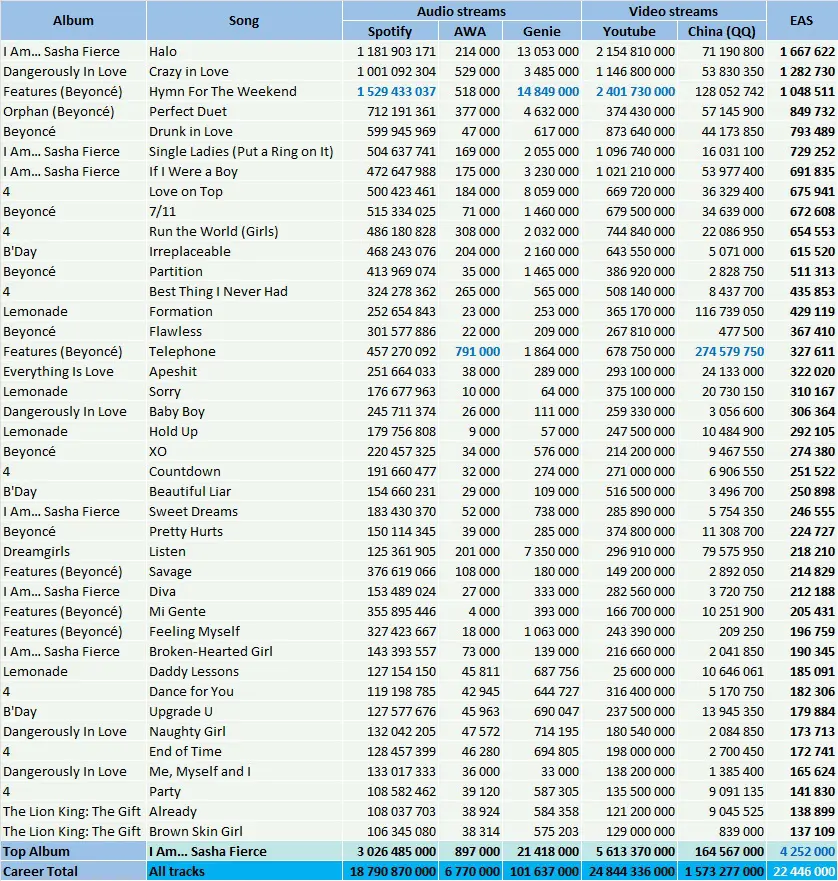
The most streamed songs from Beyoncé are pretty weird in a way. Several reasons lead to a top 5 that seems quite surprising at first.
Halo was nowhere near as big as Singles Ladies and If I Were a Boy upon release, but someway it went on to become far and away the 00s female song with the best lasting appeal. It topped a billion on Spotify and 2 billion on YouTube.
Crazy In Love, her 2003 solo hit, is a stunning runner up. The track just ended to crack a billion streams on Spotify, while it got there some time back on YouTube.
In 3rd position is the effective biggest streaming hit, Coldplay's Hymn For The Weekend, but Beyoncé is awarded 50% of its equivalent album sales due to her feature condition.
She shares credit with Ed Sheeran on Perfect Duet, but she is part of only one of the 3 major versions. Hers still adds for 850,000 EAS.
It's only after these songs that we start to see the ones we would expect on top like Drunk in Love, Single Ladies, If I Were a Boy, and more, while we still waiting for tracks from her last album Lemonade, or even Everything Is Love.
Beyoncé, the 2013 album, came out just beffore the explosion of streaming. Her big 2006-2011 albums were released even before, so performance of their tracks entirely rely on their catalog appeal, which isn't always reflective of the original chart peaks.
Lemonade was first issued on TIDAL only. This strongly limited its streaming impact, while boosting its pure sales. It explains why the highest ranked song from the album, Formation, is outside of her top 10.
As for Everything Is Love, the album failed to gain traction. Rather than appealing to everyone, it alienated fan bases of both Jay-Z and Beyoncé.
It's worth noting the overall strenght of her catalog. Every song in her top 40 has over 100 million streams, which is incredible considering the average age of these songs.
Totals are also outstanding. The 2008 effort I Am... Sasha Fierce records 4.25 million equivalent album sales from streaming.
Career-wise, she is up to 18.79 billion streams on Spotify and 24.84 billion on YouTube.
Full catalog breakdown
If you are familiar with the artist's catalog and want to check details of each and every song, you can access to all of them right here.
Keep yourself up to date
Our website provides you a fantastic tool which fetchs updated Spotify streams as you request them, use it to watch these results grow day after day!
Beyoncé compilations sales
It sounds fairly logical to add together weighted sales of one era - studio album, physical singles, downloads, streams - to get the full picture of an album's popularity. For older releases though, they also generate sales of various live, music videos and compilation albums.
All those packaging-only records do not create value, they exploit the value originating from the parent studio album of each of its tracks instead. Inevitably, when such compilations are issued, this downgrades catalog sales of the original LP. Thus, to perfectly gauge the worth of these releases, we need to re-assign sales proportionally to its contribution of all the compilations which feature its songs. The following table explains this method.
The distribution process

How to understand this table? In the example of The Beyoncé Experience Live, these figures mean it sold 1,150,000 units worldwide. The second statistics column means all versions of all the songs included on this package add for 3,990,765 equivalent album sales from streams of all types.
The second part on the right of the table shows how many equivalent streams are coming from each original album, plus the share it represents on the overall package.
Thus, streaming figures tell us songs from the Dangerously In Love album are responsible for 54% of The Beyoncé Experience Live track list attractiveness. This means it generated 618,000 of its 1,150,000 album sales and so forth for the other records. We then apply this process to all compilations present on the table.
Compilations sales figures listing
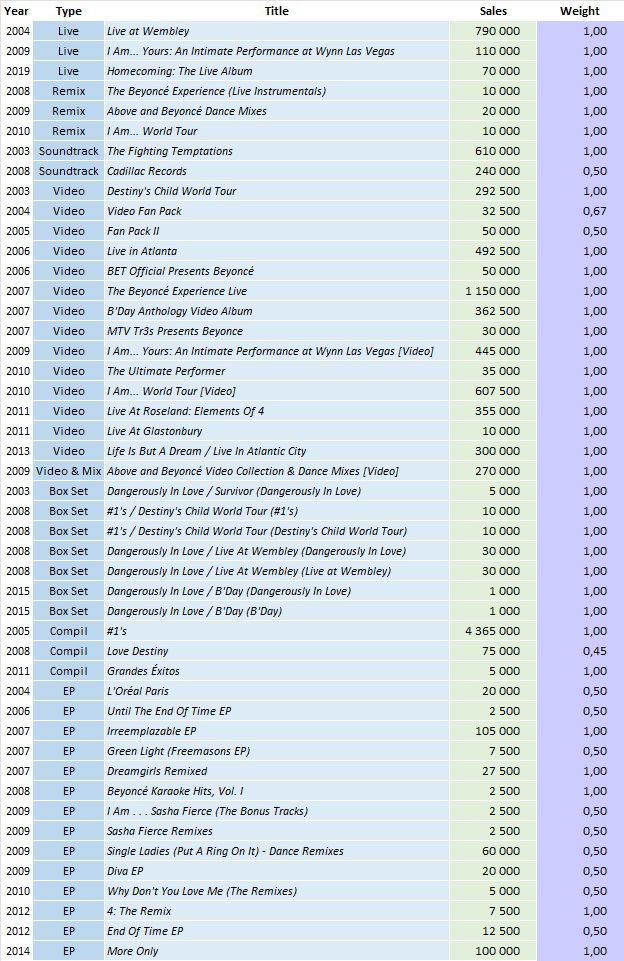
While she has no compilation album to her name, Beyoncé's reputation of amazing performance enabled her to sell an awful lot of music videos.
She issued as many as 8 big ones which total 4.28 million sales. On top of that, she released two dozens of side records, from EP of bonus tracks to 2-CD boxes, while also participating strongly on soundtracks like The Fighting Temptations and Cadillac Records.
The large majority of these sales are powered by the trio Dangerously In Love - B'Day - I Am... Sasha Fierce.
Full Length related records Sales – Summary

Here is the most underestimated indicator of an album’s success - the amount of compilation sales of all kinds it generated.
Due to the dependency of sales of the original studio albums on these releases, they are a key piece of the jigsaw.
These numbers are obtained by applying the method from the section The distribution process to all packages listed under Compilation sales figures listing category.
Total Album (all types) Sales per Country
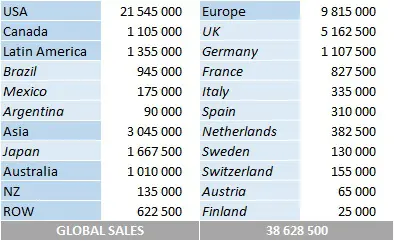
Please note country-specific numbers may miss sales of a few minor releases, although totals are complete.
Beyoncé Career CSPC Results

So, after checking all the figures, how many overall equivalent album sales has each album by Beyoncé achieved? Well, at this point we hardly need to add up all of the figures defined in this article!
Albums CSPC results
[xyz-ips snippet="updatedCSPCalbums"]
Beyoncé perfectly switched from the https://chartmasters.org/cspc-destinys-child-popularity-analysis /">Destiny’s Child to her solo career with the smash era Dangerously In Love. Shifting 10 million pure album sales, the record has been a force in every metrics.
Released several years before the digital period, it still moved an impressive 6.8 million equivalent album sales there. It's up to almost 20 million in total.
B’Day comes as an impressive sophomore effort with a total closing in 15 million EAS. It generated plenty of downloads and ringtones upon release and continues to be successful on streaming.
I Am… Sasha Fierce completes a perfect trio. It is one of the rare albums with more than 7 million EAS from both pure album sales and downloads.
It also crushes the competition on streaming, its stunning climb has now brought it to the magical 20 million mark, over 22 million to be more precise.
Among the 20 most successful 2000s albums, she is the only singer with 3 entries, and that doesn't even consider the Destiny's Child's Survivor!
4, Beyonce and Lemonade are all on a lower league but they maintain very healthy numbers.
The first two have already hit the 10 million mark, while all 3 albums combine for nearly 28 million EAS. The most interesting part is obviously their huge streaming results which will grant them continuous sales in the future.
What about her albums released this decade? Renaissance and Cowboy Carter are on their way to hitting 5 million and 3 million, respectively, with streaming units accounting for more than 80% of each album. Such numbers are highly respectable for someone so deep into their career, exemplifying Beyoncé's continuing commercial appeal in the streaming age.
Among side projects, Dreamgirls did well as it tops 4 million sales, while the same can't be said about both Everything Is Love and The Lion King: The Gift, which won't be able to do much more than hitting a million.
Up to date, Beyoncé stands at over 108 million equivalent album sales, firmly placing her as one of the biggest-selling female artists of all time.
Singles CSPC results
The list is compiled in album equivalent sales generated by each song. Therefore, these figures are not merged units of singles formats. Instead, it includes weighted sales of the song's physical single, download, ringtone and streaming as well as its share among sales of all albums on which it is featured.
1. 2003 - Beyoncé ft. Jay-Z - Crazy in Love [Dangerously In Love] - 9,780,000
2. 2008 - Beyoncé - Halo [I Am… Sasha Fierce] - 6,990,000
3. 2006 - Beyoncé - Irreplaceable [B'Day] - 5,120,000
4. 2008 - Beyoncé - Single Ladies (Put a Ring on It) [I Am… Sasha Fierce] - 4,030,000
5. 2008 - Beyoncé - If I Were a Boy [I Am… Sasha Fierce] - 3,370,000
6. 2006 - Beyoncé - Listen [Dreamgirls] - 2,940,000
7. 2003 - Beyoncé ft. Sean Paul - Baby Boy [Dangerously In Love] - 2,590,000
8. 2013 - Beyoncé ft. Jay-Z - Drunk in Love [Beyoncé] - 2,260,000
9. 2011 - Beyoncé - Love on Top [4] - 2,150,000
10. 2007 - Beyoncé & Shakira - Beautiful Liar [B'Day] - 2,140,000
11. 2011 - Beyoncé - Run the World (Girls) [4] - 1,990,000
12. 2013 - Beyoncé - 7/11 [Beyoncé] - 1,640,000
13. 2011 - Beyoncé - Best Thing I Never Had [4] - 1,600,000
14. 2005 - Beyoncé - Check On It [B'Day] - 1,590,000
15. 2003 - Beyoncé - Naughty Girl [Dangerously In Love] - 1,500,000
If you feel inspired by this list, we just created this CSPC Beyoncé playlist on Spotify!
Discography results
Thanks to our new ASR (Artist Success Rating) concept, we know that her sales represent 18.32 million times the purchase of her entire discography. Coupled with their total sales, it translates into an ASR score of 229.
It is similar to the score of artists like Robbie Williams and Rihanna. The ranking of all artists studied so far is available too at this link.
Records & Achievements
- Beyonce is the only artist ever who led the US Billboard Hot 100 with one song for 10 weeks or more both as a leading solo act and as part of a group.
- At 46 weeks, Beyonce is the 8th artist (3rd among women) with the most weeks at #1 on the Billboard Hot 100.
- When Halo crossed the mark, it was the oldest female song with more than 1 billion views on YouTube.
- Beyonce‘s first 6 studio albums topped the US BB200 Chart. She is the only female artist ever to achieve this feat.
- At 19,861,000 EAS, Dangerously In Love is the 4th most successful album from 2003.
- At 14,947,000 EAS, B’Day is the 3rd most successful album from 2006.
- At 22,296,000 EAS, I Am… Sasha Fierce is the 3rd most successful album from 2008.
- At 10,862,000 EAS, Crazy in Love is among the 3 most successful songs from 2003.
NB: EAS means Equivalent Album Sales.
Dynamic Spotify Key Performance Indicators
Please note that numbers below are retrieved automatically, so they will evolve day by day unlike previously listed data which is valid as of the publication date of the article.
[xyz-ips snippet="ArtistRandomDetails"]
As usual, feel free to comment and / or ask a question!
Sources: IFPI, Spotify, YouTube, Discogs.
You may be interested in…
... Beyoncé's streaming masters analysis
… best-selling artists, albums, and singles
We have created amazing cross-artists tops. Click to see all CSPC and raw sales results compiled so far!
... similar artists
the site is so "serious" that in the last ego update it had 1,800,000, and now it is with 1,730,000
first artist I see losing sale.
Some questions:
UK's sales dropped a lot and surprised me. I had noticed 4 sold 710.000 there for example. Is this number with streams?
4: The Remix was certified Silver in UK. You estimated 20.000 copies only. Is this correct?
BEYONCÉ has no increase in US' sales and a huge drop in UK. I though this album had a better performance as catalog for so negative updates.
You posted that BEYONCÉ sold 100.000 copies in Brazil but it had 2 codes: AA100000 from Standart Edition and AA15000 from Platinum Edition.
The increase I was expected. Good job and thanks!!!
That's enough for now.
Great!
Shouldn't her worldwide album sales amount be 37,630,000 if we include sales outside of her studio albums? She sold 4,2 million with live/remix albums.
"The only female in the last 20 years to have 3 albums to hit B'day level with sps."
What do you mean? I didn't understand exactly.
He’s dropped just about every artist’s pure sales as he updates them because he was overestimating certain markets. There have been plenty of articles pointing this out. Coldplay and Britney Spears were the first to have it happen.
Hi Miguel!
The fact that we care about fixing former flaws, we care about looking for optimization and we care about being fully transparent about it is precisely what makes us a serious site. Sites sticking to massively inflated numbers for decades are the ones which can't be considered seriously 😉
Hi KantClark!
I got various DUS figures (the UK equivalent of Soundscan) figures for Bey and noticed that she has been getting massive streaming units lately with her albums. Previously, I had underestimated the share of SEA from her recent catalog sales.
If we take the example of 4, it indeed scanned 710,000 units to date overall, with streams. For catalog albums, streams use to be fairly low, but Beyoncé's patterns are different. Here is some data:
- by 07/04/2012, scanned 541,007 units
- by 11/05/2013, scanned 603,548 units, an increase of 1,097 copies per week during 57 weeks
- by 08/03/2014, scanned 624,965 units, an increase of 498 copies per week during 43 weeks
- by 09/05/2015, scanned 635,864 units, an increase of 179 copies per week during 61 weeks
This last figure is key: 179 copies sold per week, with the market going down by nearly 20% per year since then and the album getting older and older. From that date, the album started to sell 600 copies per week from one day to another, it was simply because streaming got included. That fueled its pure sales from 635k to 710k in less than 3 years, although its pure sales were already down to under 200 copies per week by early 2015. I estimated 150 sales per week for the year following the 09/05/2015 update, 125 sales per week the following year and 100 copies a week this last year. That's 19k pure sales since it had scanned 636k, bringing it to 655k. That's why it is shown as 660k accounting for a few copies remaining on shelves.
I took the example of 4 to get into the details, but the situation is true for all her albums. B'Day was on 390,263 DUS sales by May 2013 selling a mere 8k during the last 214 weeks, barely 2k/year. Both Beyonce - Platinum Ed. and 4: The Remix were certified almost exclusively on the back of streaming points too.
About Beyoncé in Brazil, with 115k codes plus downloads, a standard estimate would have been anything from 130k to 150k. The point is that it got 100k shipped upon release and then never got an AB code. It's a clear case of a massive over-shipment. The album never entered the Top 10 album chart in sales to consumers. The last key element is that Lemonade started with "only" 40k shipped, which also suggests the self-titled effort first shipment was too large. We are left with following elements:
- IASF shipped 360k (I include est. for downloads)
- 4 shipped 160k
- Beyoncé hasn't sold its 115k units shipped but still sold enough to justify 40k copies shipped upon release for its follow up
- Lemonade shipped 50k
Following her trend of sales, I went for 100k assuming it is the most realistic figure for net shipment to date.
Hi JRVV!
Her Top 25 songs by US Ringtones stand as below:
1 - Irreplaceable - 3,750,000
2 - Check On It - 1,800,000
3 - Baby Boy - 1,600,000
4 - Single Ladies (Put a Ring on It) - 1,450,000
5 - Crazy in Love - 1,250,000
6 - Halo - 1,100,000
7 - Diva - 1,000,000
8 - Ring the Alarm - 850,000
9 - Dangerously in Love - 800,000
10 - If I Were a Boy - 700,000
11 - Love in This Club, Pt. II - 700,000
12 - Me, Myself and I - 650,000
13 - Beautiful Liar - 625,000
14 - Ego - 600,000
15 - Telephone - 600,000
16 - Until the End Of Time - 600,000
17 - '03 Bonnie & Clyde - 550,000
18 - Listen - 500,000
19 - Sweet Dreams - 500,000
20 - Naughty Girl - 450,000
21 - Upgrade U - 450,000
22 - Déjà Vu - 350,000
23 - Get Me Bodied - 350,000
24 - Video Phone - 200,000
25 - Best Thing I Never Had - 150,000
Hi Ingrid!
Most of these 4,2 million sales from remaining long formats come from music videos which aren't tallied on this global album sales figures!
Basically, she is the only female artist from her generation with 3 different albums over 13,5m CSPC. Accounting for all acts, only Eminem and Coldplay did it too.
Seeing that all of Beyoncé's outputs in the 2000's were 14M+, does this make her the biggest female artist of the 2000's, or is it Britney Spears?
Speaking only about album sales was Britney. Looking for all aspects and considering that Bey was big with DC's too, definitly Beyoncé was the biggest female act of 00's.
The way she just stopped caring about charts is stupid. Both 4 and BEYONCÉ could've been bigger if she would have just gave the world iasf 2.0-3.0
What about her US top 10 digital singles? Has single ladies topped 5.8M or halo 4M?
Great numbers! Thanks for the update?
But I have a quick question, why did Halo and If I Were A Boy gain so much (the former +2.4M), while Single Ladies gained only about 600K
Halo selling 13M makes it the highest selling solo digital single by a black female artist. Topping we found love.
Hi MJD ! 🙂
How the fuck 4 stay at 7.8 M and BEYONCE went from 7.9M to 7.6M ?
Both of these albums gained so much streams in 2017. Both should've had reach 8M copies sold since December 2016.
What is that mess ? Explain sis.
And I want a clear anwser, don't even try to fool my ass or I'll sting yours. >:(
Love you !
Thanks! Very clarifying. You just forget to respond me about 4 The Remix. It was certified Silver in UK. I really doubt that streams were so huge for add so many equivalent sales. I think 20.000 copies sold worldwide is very very conservative. Good job one more time.
Why exactly do you have N/A for certain countries/continents? I feel as tho you should have all the numbers (no matter how small), posted by each market.
